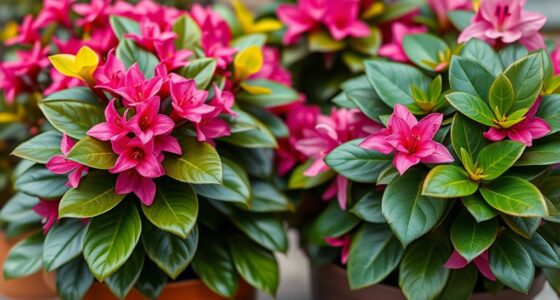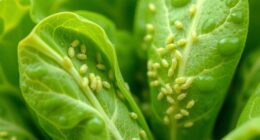Fertilizer 101 helps you understand N-P-K, the three primary nutrients your plants need: nitrogen (N) for leafy growth, phosphorus (P) for roots and flowers, and potassium (K) for overall health and disease resistance. Knowing what your plants require and how these nutrients work together permits you to select the right fertilizer mix. Using the proper balance guarantees your plants thrive. Keep exploring, and you’ll discover how to optimize fertilizer use for healthy, vigorous plants.
Key Takeaways
- N-P-K stands for Nitrogen, Phosphorus, and Potassium, the primary nutrients in fertilizers.
- Different plants require varying N-P-K ratios based on growth stage and nutrient needs.
- Nitrogen promotes leafy growth, phosphorus supports root and flower development, potassium enhances overall plant health.
- Understanding N-P-K ratios helps you select the right fertilizer for specific plant requirements.
- Balanced fertilization ensures optimal nutrient absorption and healthy, vigorous plant growth.

Have you ever wondered how plants thrive so well in your garden? The secret often lies beneath the surface, in the soil you’re working with. Understanding soil pH and how it interacts with your plants’ needs is essential for successful gardening. Soil pH measures the acidity or alkalinity of your soil on a scale from 0 to 14. Most plants prefer a slightly acidic to neutral pH, around 6.0 to 7.0. If your soil is too acidic or too alkaline, your plants may struggle to absorb crucial nutrients, even if you’re applying fertilizer regularly. To get a clear picture, you can test your soil pH using affordable testing kits. Once you know your soil’s pH, you can amend it to better suit your plants’ needs. Organic amendments like compost, peat moss, or pine bark can help adjust soil pH gradually while enriching the soil with organic matter. These amendments also improve soil structure, aeration, and moisture retention, creating a healthier environment for roots to grow. Additionally, understanding self watering plant pots can help you maintain consistent moisture levels, which further supports nutrient uptake and plant health.
Adding organic amendments isn’t just about adjusting pH; it’s about building a thriving ecosystem underground. When you mix compost into your soil, you introduce beneficial microorganisms that help decompose organic matter, releasing nutrients in forms plants can easily absorb. This process not only boosts nutrient availability but also enhances the overall fertility of your garden. Organic amendments work hand-in-hand with your understanding of soil pH to ensure your plants receive a balanced diet. For example, if your soil is too acidic, incorporating lime can raise the pH, but supplementing with compost can buffer the pH change and provide a steady release of nutrients. Conversely, if the soil is too alkaline, sulfur or peat moss can help lower the pH, complemented by organic matter that supports healthy microbial activity.
Frequently Asked Questions
How Do I Choose the Right Fertilizer for My Specific Plants?
To choose the right fertilizer, start by testing your soil to understand its nutrient levels. Then, consider your plants’ specific nutrient requirements—some need more nitrogen for leafy growth, while others thrive with higher phosphorus for root development. Match your fertilizer’s N-P-K ratio to these needs, and always follow application instructions. This approach guarantees your plants get balanced nutrition, promoting healthy growth and better yields.
Can I Over-Fertilize and Harm My Plants?
Yes, over-fertilizing can harm your plants by causing plant toxicity and fertilizer burn. When you give too much fertilizer, it stresses your plants, leading to leaf scorch, wilting, or even death. Always follow the recommended application rates and frequency. Regularly check your plants for signs of distress, and if you notice issues, flush the soil with water to reduce excess nutrients and prevent further damage.
What Are Organic vs. Synthetic Fertilizers?
You might wonder about organic versus synthetic fertilizers. Organic options come from natural sources, helping maintain soil health and reducing environmental impact. Synthetic fertilizers are manufactured chemicals that provide quick nutrients but can harm soil over time and contribute to pollution. Choosing organic fertilizers supports healthier soil and a better environment, while synthetic options may boost growth faster but risk long-term soil degradation. Consider your plant needs and environmental goals when selecting fertilizer types.
How Often Should I Fertilize Different Types of Plants?
For fruitful flourishing, follow frequency, form, and factors. You should fertilize houseplants monthly, garden veggies every 4-6 weeks, and trees seasonally. Always start with soil testing to determine specific needs, then stick to recommended fertilizer application rates. Over-fertilizing risks damage, while under-fertilizing stunts growth. Adjust your approach based on plant type, growth stage, and environmental conditions, ensuring your plants stay healthy and happy throughout the seasons.
Are There Signs My Plants Need More or Less Fertilizer?
If you notice signs of deficiency like yellowing leaves, stunted growth, or leaf spots, your plants might need more fertilizer. Conversely, if you see fertilizer damage, such as browning leaf tips or wilting, you should cut back. Pay close attention to these signs; adjusting your fertilization schedule accordingly helps prevent over- or underfeeding, keeping your plants healthy and thriving.
Conclusion
Now that you understand the dance of N-P-K, you hold the key to nurturing your plants’ symphony of growth. Think of fertilizers as the maestro’s baton, guiding each element to perform in harmony. When you choose wisely and apply with intention, your garden blooms like a vibrant canvas, alive with color and essence. Remember, your knowledge is the seed—nurture it, and watch your plants flourish as if touched by nature’s own magic.









